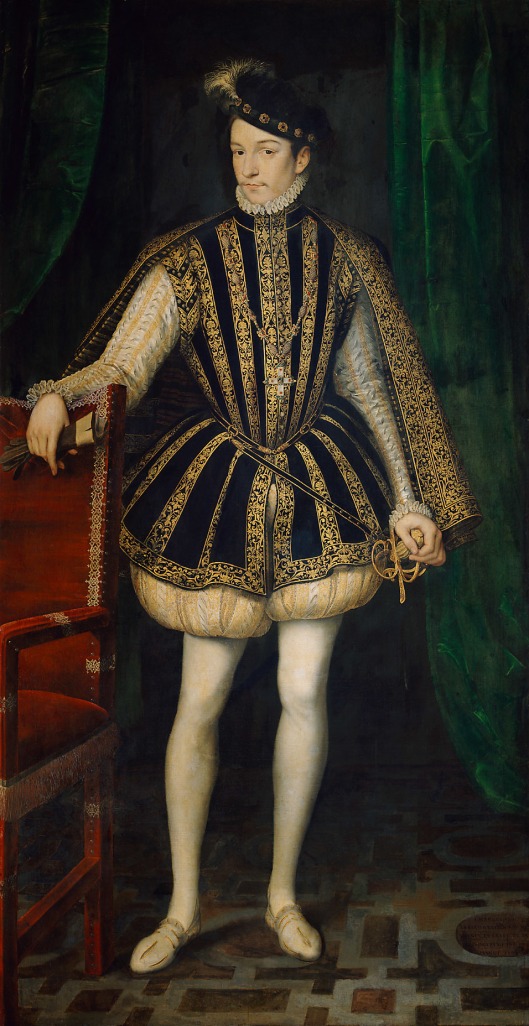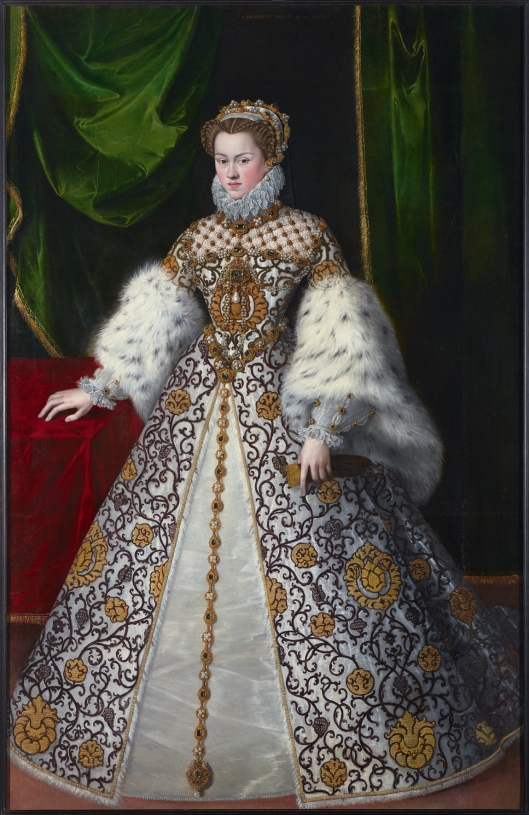Tags
Archduchess Elisabeth of Austria, Catherine de Médici, King Charles IX of France, KIng François II of France, King Henri II of France, King Henri III of Navarre, King Henri IV of France and Navarre, Queen Mary I of Scotland, Queen of France, St. Bartholomew's Day massacre
Charles IX (June 27, 1550 – May 30, 1574) was King of France from 1560 until his death in 1574. He ascended the French throne upon the death of his brother François II in 1560, and as such was the penultimate monarch of the House of Valois.
Prince Charles Maximilien of France, third son of King Henri II of France and Catherine de’ Medici, the daughter of Lorenzo de’ Medici, Duke of Urbino, and Madeleine de La Tour d’Auvergne.
Prince Charles Maximilien was born on June 27, 1550 at the Château de Saint-Germain-en-Laye. He was the fifth of ten children born to the royal couple. Styled since birth as Duke of Angoulême, he was created Duke of Orléans after the death of his older brother Louis, his parents’ second son, who had died in infancy on October 24, 1550.
Charles’ father, King Henri II, died in 1559, and was succeeded by Charles’ elder brother, King François II, who was married to Queen Mary I of Scotland. Therefore, François II was also King Consort of Scotland and died at a young age in 1560.

King Charles IX of France
The ten-year-old Charles Maximilian was immediately proclaimed King Charles IX of France on December 5, 1560, and the Privy Council appointed his mother, Catherine de’ Medici, as governor of France (Regent) with sweeping powers, at first acting as regent for her young son.
On 15 May 1561, King Charles IX was consecrated in the cathedral at Reims. Prince Antoine of Bourbon, himself in line to the French throne and husband to Queen Joan III of Navarre, was appointed Lieutenant-General of France.
Charles IX’s reign saw the culmination of decades of tension between Protestants and Catholics. Civil and religious war broke out between the two parties after the massacre of Vassy in 1562.
On November 26, 1570, Charles married Archduchess Elisabeth of Austria, with whom he fathered one daughter, Princess Marie Elisabeth of France. In 1573, Charles fathered an illegitimate son, Charles, Duke of Angoulême, with his mistress, Marie Touchet.
Archduchess Elisabeth of Austria was a member of the House of Habsburg, she was the daughter of Maximilian II, Holy Roman Emperor, and his wife and his first cousin, Infanta Maria of Spain, and she herself was the daughter of Holy Roman Emperor Charles V (Carlos I of Spain) and Infanta Isabella of Portugal.

Archduchess Elisabeth of Austria, Queen of France
In 1572, following several unsuccessful attempts at brokering peace, Charles IX arranged the marriage of his sister Margaret to King Henri III of Navarre, a major Protestant nobleman in the line of succession to the French throne, in a last desperate bid to reconcile his people.
Facing popular hostility against this policy of appeasement and at the instigation of his mother Catherine de’ Medici, Charles IX oversaw the massacre of numerous Huguenot leaders who gathered in Paris for the royal wedding, though his direct involvement is still debated.
This event, known as the St. Bartholomew’s Day massacre, was a significant blow to the Huguenot movement, and religious civil warfare soon began anew. Charles IX sought to take advantage of the disarray of the Huguenots by ordering the siege of La Rochelle, but was unable to take the Protestant stronghold.
Many of Charles’ decisions were influenced by his mother, a fervent Roman Catholic who initially supported a policy of relative religious tolerance. However, after the events of St. Bartholomew’s Day Massacre, he began to support the persecution of Huguenots.
However, the incident haunted Charles IX for the rest of his life, and historians suspect that it caused his physical and mental health to deteriorate in his later years. King Charles IX died of tuberculosis in 1574 without legitimate male issue, and was succeeded by his brother as King Henri III of France, whose own death in 1589 without issue allowed for the ascension of King Henri III of Navarre to the French throne as King Henri IV of France and Navarre establishing the House of Bourbon as the new French royal dynasty.
